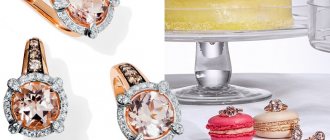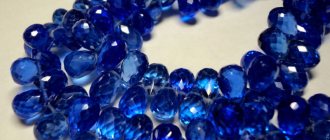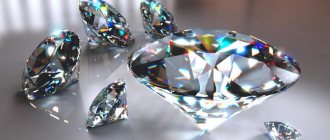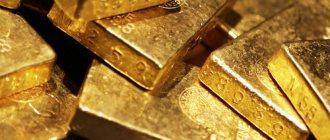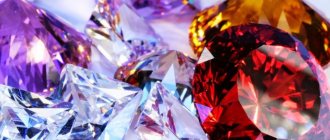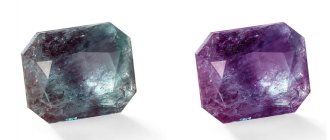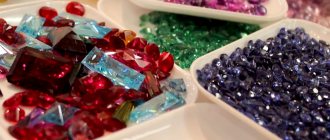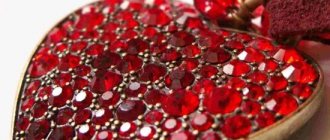Today, the jewelry industry has reached such a level that fashionable and beautiful products are made from almost any material. Conventional precious stones often fade into the background, giving way to more budget-friendly semi-precious and ornamental stones. But not all customers know how the inserts differ from each other and why prices vary so much for minerals that are similar in appearance. To understand this, let’s take a short excursion into the history of the jewelry industry and consider each type of insert separately.
Gems
The most expensive and most valuable inserts. What is the reason for the high cost of such minerals? Let's figure it out in order.
The first thing to consider is that gems are natural minerals formed in a complex way in the earth’s crust. Accordingly, a gemstone can be called such only if it is rare in nature .
Jewelry with cognac diamonds in the “Chocolate” collection
Let us present some statistical data from world practice. The relative cost of mining the most expensive stones as a percentage of the cost of total mining at the beginning of the 21st century was as follows: emeralds - 43, rubies - 14, opals - 10, sapphires - 6, jadeite - 6, turquoise - 5, other colored stones - 16%. This shows that the high cost of precious stones is due, first of all, to the complexity of their extraction.
What other indicators can identify a gemstone among all the others?
Hardness _ The mineral should not be exposed to external influences - scratched or chipped. In Russia, in accordance with the Federal Law “On Precious Metals and Precious Stones,” this list includes natural diamonds, emeralds, rubies, sapphires, alexandrites, and pearls. Unique amber formations are also considered precious stones. From this we see that its high cost is quite understandable.
In addition, the degree of its fashionability . Simply put, the more an accessory falls under the definition of a “fashion trend,” the higher its cost.
The world of precious stones is very large and, unfortunately, confusing, especially when viewed superficially. At the moment, over 2.5 thousand minerals are known, but only a little more than a hundred of them are valuable from the point of view of the jewelry industry and decorative arts.
It is quite difficult to understand the intricacy of varieties of precious, semi-precious and ornamental stones, but there are also valuable natural formations that are not minerals. Therefore, within the framework of this publication, several approaches to the classification of valuable minerals and natural formations will be considered.
Magical properties of ornamental minerals
The valuable ornamental stone citrine has shades from lemon to amber. This shining transparent mineral will save its owner from depression and blues by sharing its solar energy with him, will bring good luck in business and attract material well-being.
Rose quartz has a delicate color and equally delicate texture. This gem will highlight the romantic nature of its owner. Rose quartz is very popular with young girls and very little girls. This mineral increases the likelihood of a happy marriage and brings good luck in love.
Lithotherapists believe that gems have a special energy field and, if its vibrations coincide with the vibration of the human body, then the mineral can have a positive effect on health. Since ancient times, astrologers have argued that each gem must correspond to a certain zodiac sign, then its energy will protect a person and increase his capabilities. Both are right.
A pretentious diamond has no soul; it will adorn any woman who wants to emphasize her status in society. A semi-precious gem is chosen by the owner, and if the choice is correct, it will unobtrusively emphasize the natural beauty of a woman, protect her from troubles, and help her in love. The list of advantages of this stone goes on and on. And maybe someday he will tell his owner how many centuries ago the birds sang and the sun shone. As it was when he was not yet a stone.
What types of gems are there?
The names of precious stones and minerals (which, in fact, are the same thing) are presented differently in different classifications, since a unified system has not yet been developed. From a generally accepted point of view, only the most beautiful, rare and expensive minerals and other natural formations can be considered precious stones.
According to Article 1 of the Federal Law of March 26, 1998 No. 41-FZ, officially precious stones are exclusively diamonds, rubies, emeralds, alexandrites and sapphires, as well as pearls of natural origin, that is, organics. Amber is also sometimes included here, but with certain unique features - special inclusions, heavy weight, and so on.
Ring from the “Diamonds of Yakutia” collection in Sunlight
However, there are also nuances here: precious stones in jewelry look very impressive and cost accordingly. But very small or defective minerals lose a lot in value, while semi-precious semi-precious gems of large sizes and rare colors can be equal in value to first-order precious stones.
The science that studies precious stones is called gemology. This is a special section of mineralogy devoted to precious, jewelry, semi-precious and ornamental stones.
Table of precious stones according to the classification of the prominent Soviet and Russian mineralogist E.Ya. Kievlenko seems the most logical and easy to understand. Based on it in the light of modern realities, Doctor of Geological and Mineralogical Sciences E.P. Melnikov proposed an improved version of the classification.
Without going into detail, there are four groups of valuable minerals:
- Gems. Diamond, classic blue sapphire, ruby, alexandrite, emerald and natural sea pearls.
- Jewelry stones. They are divided into four orders. Among the most famous: sapphires of fancy colors, spinel, opals, tanzanite, various types of beryl and corundum (except precious ones), tourmalines, zircons, garnets, freshwater and sea cultured pearls, amethyst, aquamarine, citrine, tiger and cat's eye, apatite, mother of pearl, certain types of quartz and others.
- Jewelry and ornamental stones. Malachite, turquoise, jadeite, lapis lazuli, pink and smoky quartz, jasper, ordinary opals, rock crystal, special grades of jasper, jade, agate, chrysoprase and others.
- Ornamental stones. Jasper, marble onyx, jet, goldite, obsidan, certain types of granite and other ornamental materials of mineral origin.
In addition to pearls, the classifier also includes other materials of organic origin. These are corals, mammoth and ivory. They are considered jewelry and ornamental stones.
Price for semi-precious stones
You can purchase jewelry and nuggets only in trusted places. Due to the fact that many fakes are supplied today, there is a chance that you will buy yourself a useless piece of jewelry that will not have all those magical and healing properties. Natural stones are expensive, especially some types: turquoise, jade, ruby, moonstone, amber. Approximate cost of jewelry:
| Name of the stone | Price, rubles |
| agate | from 700 |
| aventurine | from 400 |
| alexandrite | from 30000 |
| turquoise | from 1500 |
| heliodor | from 2000 |
| pomegranate | from 800 |
| jade | from 300 |
| quartz | from 200 |
| lapis lazuli | from 600 |
| malachite | from 1500 |
| nephritis | from 1500 |
| obsidian | from 1000 |
| onyx | from 200 |
| opal | from 1000 |
| sardonyx | from 300 |
| cornelian | from 300 |
| tourmaline | from 1000 |
| chalcedony | from 600 |
| chrysoberyl | from 1000 |
| amber | from 2000 |
The most expensive gems
We will not repeat the above: the most expensive in the ranking of precious stones in terms of value are the last five positions described above. These are gems of the first order and the highest value according to any classification.
But you need to understand that it is impossible to compile an objective list of stones by value: the cost of a carat of a mineral depends not only on its chemical formula, but also on purity, transparency, size, color, presence/absence of defects and other parameters.
Therefore, in this nomination we will present the rarest and most expensive minerals that go beyond generally accepted standards. So, here is a list of truly unique stones, valued at fortunes:
- Tsavorite. Jewelry garnet is yellowish-green in color. A carat costs about 3-5 thousand US dollars.
- Sapphire. An unheated stone of pure blue color is estimated at a minimum of 4.5-6 thousand dollars/carat.
- Red spinel. It is considered one of the fastest growing minerals in price: the cost is 6-8 thousand dollars per carat.
- Demantoid. Another green garnet, but a piercing pure color. Ural demantoid costs about 10 thousand dollars/carat.
- Paraiba. Neon blue tourmaline that glows in the dark. Average quality stones cost 8-12 thousand dollars/carat.
- Emerald. Flawless pure emeralds are extremely rare. The cost of a carat of high-quality unoiled emerald starts from 10-13 thousand dollars
- Padparadscha. The sapphire is an incredible orange-pink color. Cost – 10-12 thousand dollars/carat.
- Alexandrite. The price of this stone ranges from 10-37 thousand dollars/carat. The most expensive are those mined in Russia.
- Ruby. A clean large stone of the top color “pigeon blood” is estimated at 15-25 thousand dollars/carat.
- Jade. The rarest transparent jadeite, known as “imperial”, costs at least 20 thousand dollars per carat.
- Diamond. The cost of a high-quality colorless diamond is about 15 thousand dollars per carat. A blue diamond costs about 30-50 thousand. And the most expensive gemstone in the world is the red diamond: a carat is estimated at 500 thousand - 1 million dollars.
Paraiba Tourmaline
Zircon
The name of the mineral comes from Persian, meaning “like gold.” Zircon crystals have a golden color; pink or transparent colorless is less common. Reddish-brown specimens are called hyacinth . Using heat treatment, you can get a stone of a beautiful blue color - starlite .
In the modern world, the term zircon increasingly refers to synthetic inserts - cubic zirconia (Cubic Zirconia), but they have nothing in common, just an inaccurate translation of a foreign name.
Natural zircon will help its owner with fatigue, restore spent energy, and give a healthy, restful sleep.
What is the difference between precious and semi-precious
There are no objective parameters that distinguish precious stones from semi-precious ones. The main criterion in this case is the price: semi-precious ones are inexpensive, precious ones are not accessible to everyone.
In the classification of the All-Russian Research Institute of Jewelry Industry there is no concept of precious and semi-precious stones at all: they can be jewelry, semi-precious and jewelry-precious.
Precious stones mined in Russia are highly valued on the world market. Moreover, the Russian Federation has deposits of almost all precious minerals, with the possible exception of rubies.
Tanzanite
Compared to other semi-precious stones that have a long history, tanzanite is a newcomer to this large family.
It was discovered in Tanzania in 1966, at first it was mistaken for sapphire, but a year later justice was restored, the mineral was named after the country where it was discovered. So far, no new deposits of this beautiful crystal have been found.
Jasper, malachite , and jade are very popular all over the world , however, they are rarely used as inserts in jewelry, but rather they can be called ornamental stones.
The cost of precious gems directly depends on their size and quality characteristics; some so-called “semi-precious” minerals can be valued more than the most precious ones and serve as a worthy decoration for the mineralogical collections of the world’s leading museums, as unique, inimitable creations of nature.
Classification of stones by properties
The classification of precious stones takes into account all kinds of physical, optical and other characteristics. The most obvious characteristic of gemstones is their weight. With all other qualities being equal, a carat of a large mineral will cost more than a similar unit of a small one (sometimes by several times).
Carat is a unit of weight of precious stones, accepted by jewelers all over the world. One carat is only 0.2 grams!
All other properties of precious stones can be combined into the following broad groups:
- Rarity. The rarer the mineral, the higher its value. It’s enough for a large deposit to be depleted, and the stone immediately soars in price.
- Feeling. Tactile sensations when touched (“soapiness”, slipperiness, etc.).
- Density. The denser the stone, the heavier it is. Zircon is even heavier than diamond. The lightest is amber.
- Hardness. Here it is appropriate to mention the Mohs scale, which grades the hardness of substances according to a ten-point system, from diamond (10) and corundum (9) to talc. Test - surface scratching.
- Strength. A very hard stone may not be very durable and will easily crack under physical stress. Not too hard jade is very difficult to split due to its high viscosity, and zircon crumbles instantly.
- Cleavage. The description of this characteristic is quite difficult: it is the “behavior” of the stone when splitting (in which directions it splits). It is fundamentally important when cutting.
- Electrification and polarity. For the jewelry industry, these parameters are not important.
- Transparency. Gemstones are usually transparent or translucent. The purer the stone, the more valuable it is.
- Color. Multi-colored stones can be more valuable or cheaper than their classic counterparts. Examples were given above.
- Shine. Can be diamond, glass, silky, mother of pearl and so on.
- Light refraction. A characteristic that is fundamentally important when choosing a cut.
- Dichroism and polychroism. The ability of a stone to change color depending on the angle and intensity of light.
- Asterism. The effect of a “star” inside the stone when hit by light.
- Luminescence. The ability to glow, characteristic of diamonds, rubies, jade and other stones.
- Defectiveness. Presence, location, type and number of various defects.
- Quality of cut. The value of the mineral directly depends on the quality of the cut.
- Ennoblement. A stone with good natural characteristics will always cost more than its improved (heated, oiled, painted, etc.) counterpart.
How to distinguish precious stones from artificial analogues
Artificial gemstones have the same composition as their natural counterparts. Moreover, they are, as a rule, of higher quality and purer than their natural counterparts. Various valuable crystals are grown under artificial conditions: diamonds, emeralds, rubies and others like them.
However, synthetic stones are much cheaper than natural ones (sometimes hundreds or even thousands of times). And this is explained by the fact that people tend to want to own something especially exclusive.
Almost all minerals remain cool for a long time. A fake made of glass or plastic quickly heats up in your hands. In this way, it is impossible to distinguish a precious stone from a non-precious one, but a crude imitation will immediately give itself away.
You need to understand that synthetic minerals are not fakes, that is, imitations (double stones or ordinary glass). If you buy a product in a large jewelry store, the chance of purchasing an artificial analogue or imitation without knowing it is surely close to zero. They simply won’t risk their reputation.
Gold ring with synthetic amethyst
Gold ring with natural amethyst
A non-professional will not be able to determine whether a gemstone is precious or not simply by eye. It is best to beware of buying jewelry second-hand or from small, dubious shops.
But if you somehow get your hands on a dubious specimen, an examination and evaluation of stones is at your service, which can be ordered at any jewelry workshop. Gross fakes are identified immediately, visually; in complex cases, more specific methods are required.
Aventurine
A variety of quartz, the most popular color is green with shiny inclusions. The stone has a long history, it was especially revered by the Chinese, even the emperor’s seal was made of aventurine.
Almost all products with such inserts, especially budget silver items presented in jewelry stores, are fakes called aventurine glass, produced on an industrial scale in China.
Manifestations of a craving for adventure and excitement only intensify among those who wear jewelry with the semi-precious stone aventurine.
Interesting facts about gemstones
And now some fun facts:
- The rarest gemstone in the world is grandidierite. At the moment, only eight copies are known.
- One of the most impressive collections of precious stones in the world is the Diamond Fund in the Kremlin Armory, in Moscow.
- The hardest gemstone is, naturally, diamond. It is the hardest naturally occurring substance on Earth.
There are not so many deposits of precious stones in nature, these minerals are expensive, and not everyone can afford such luxury. Don’t be upset about this: only an expert can distinguish an artificial diamond or emerald from its natural counterpart. In addition, many semi-precious stones in a classy design look no less advantageous than prohibitively expensive top-end gems.
15.02.21
Citrine
This mineral is also a type of quartz, however, it is rarer. The name comes from Lat. Citrus – lemon, has a yellow or golden color. Quite often, citrine is obtained artificially by heat treatment of less expensive aquamarine.
What is a treated diamond?
The sunshine of citrine crystals brings warmth to the soul, helps to find peace, and relieves evil thoughts.
